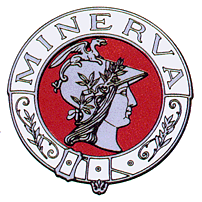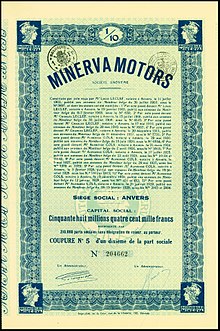Minerva (automobile)
 | |
| Industry | automobiles |
|---|---|
| Founded | Antwerp, Belgium (1900) |
| Founder | Sylvain de Jong |
| Defunct | 1956 |
| Fate | Sold to Rheinmetall |
| Headquarters | |
| Products | bicycles, motorcycles, automobiles |
Minerva was a Belgian firm active from 1902 to 1938 and a manufacturer of luxury automobiles. The company became defunct in 1956.
Founded by Dutchman Sylvain de Jong, the company initially produced safety bicycles before branching out into light cars and motorized bicycles in 1900. By 1902, Minerva added cars to its lineup. The brand achieved fame due to the quality and quietness of its Knight Engines and was favored by royalty and influential people like Henry Ford. Despite success, financial struggles during the 1930s led to its merger with Impéria Automobiles, another Belgian manufacturer.
After World War II, Minerva produced a version of the Land Rover under license for the Belgian army until 1954. A fallout with Land Rover and subsequent court case led to the end of this partnership. The company made attempts to re-enter the car market, but ceased operations in 1956.
History[edit]
In 1883, a young Dutchman, Sylvain de Jong (1868–1928) settled in Antwerp, Belgium.
Bicycles and motorcycles[edit]

Minerva started out manufacturing standard safety bicycles in 1897, before in 1900 expanding into light cars and "motocyclettes", particularly motorized bicycles which were a forerunner of motorcycles.[1]
They produced lightweight clip-on engines that mounted below the bicycle front down tube, specifically for Minerva bicycles, but also available in kit form suitable for almost any bicycle. The engine drove a belt turning a large gear wheel attached to the side of the rear wheel opposite to the chain. By 1901 the kit engine was a 211cc unit developing 1.5 hp, comfortably cruising at 30 km/h (19 mph) at 1,500 rpm, capable of a top speed of 50 km/h (31 mph), and getting fuel consumption in the range of 3 L/100 km (94 mpg‑imp; 78 mpg‑US). These kits were exported around the world to countries including the United Kingdom, France, Germany, the Netherlands, Australia, and other British territories of the time.[1]
As engine power increased, frame ruptures became increasingly common, and by 1903 Minerva had developed an in-frame design for their bicycles, with the engine mounted above the bottom bracket, while still also offering the clip-on kit. From 1904 Minerva began focusing more on car production, and while development and production of the Minerva motorized bicycles and motorcycles continued through to about 1909, they increasingly became a less significant part of the company.[1]
Minerva engines exported to the UK powered the very first Triumph, among others.[2][3] Motorcycle production would continue until 1909 or 1914, and during this period Minerva became one of the world's premier names in motorcycles and motorcycle engines.[4] (For instance Chater-Lea produced Minerva-engines in the UK.[5])
Automobiles[edit]



In 1902 De Jong added cars to his production as well with a 6 hp four-cylinder model. In 1903 he founded Société Anonyme Minerva Motors in Berchem (Antwerp). Volume car production began in 1904 with a range of two-, three- and four-cylinder models with chain drive and metal clad wooden chassis and the Minervette cyclecar. The 8-litre Kaiserpreis won the Belgian Circuit des Ardennes race in 1907.

Charles S Rolls (of future Rolls-Royce fame) was a Minerva dealer in England selling the 2.9-litre 14 hp (10 kW). The most important market for the manufacturer remained England, where at £105 the small 636 cc single-cylinder Minervette was the cheapest car on the market, followed by the Netherlands and France.
In 1908, Minerva obtained a worldwide Knight Engine license. The Knight motor, developed by Charles Yale Knight in the United States, used double sleeve valves and ran almost silently. All future Minervas would use these engines. Sporting successes continued with the new engines including the Austrian Alpine Trials and Swedish Winter Trials. Customers for the Minerva would include kings of Belgium, Sweden and Norway, Henry Ford and the Impressionist Artist Anna Boch.[6]
During World War I Sylvain de Jong and his engineers were based in Amsterdam where they maintained development of their automobiles. Minerva cars were used for hit and run attacks against the Germans initially with rifle fire and light machine guns from simply protected open topped vehicles. These vehicles became increasingly sophisticated until trench warfare robbed them of the mobility needed for their hit and run tactics.

In 1920, they returned to Belgium to restart the production of luxury cars with the 20CV 3.6-litre four-cylinder and 30CV 5.3-litre six-cylinder models.[7] The manufacturer's star rose not only in Europe, but in the United States as well where American film stars, politicians and industrialists appreciated the cars. The Minerva had the same quality as the Rolls-Royce, but was slightly less expensive. Due to the success, in 1922 a second factory apart from the primary one in Berchem was built in Mortsel for coachbuilding. In 1923, smaller models were introduced; the 2-litre four-cylinder 15CV and 3.4-litre six-cylinder 20CV with standard four-wheel brakes.[7] In 1927, the 30CV was replaced with the 6-litre AK and also a new 2-litre six, the 12-14, was introduced. Large cars continued to be a specialty of Minerva's, and in 1930 the then almost-compulsory-for-the-time straight eight was introduced in two sizes; the 6.6-litre AL and the 4-litre AP.[7] The last Minerva was the 2-litre M4 of 1934 but it did not sell well.
With the financial crisis in the 1930s, the company was restructured as Société Nouvelle Minerva but in 1934 merged with the other major Belgian manufacturer Impéria Automobiles. Impéria continued to make Minervas for a year and the AP until 1938 and from 1937 badged some of their cars and trucks for export to England and France as Minerva-Impérias. Just before the outbreak of the war, a group of businessmen from Verviers bought out Minerva.
Land Rover production[edit]

After World War II the company produced a version of the Land Rover 80" under licence for the Belgian army up to 1954. The 80" model was known as the TT (Tout Terrain). A smaller number of licence built Land Rover 86" were built from late 1953 to 1956. These vehicles had locally built steel bodywork. Some civilian sales of both the 80" and the 86" models were achieved. A number of Land Rover vehicles were also assembled for the Belgian state police (Gendarmerie / Rijkswacht). The Rijkswacht vehicles had the more traditional aluminium bodywork and front wing shape associated with Land Rover vehicles. A bitter dispute broke out between Land Rover and the Minerva company and this led to a court case, won by Minerva for breach of contract. This was the death knell of the partnership and licence arrangement. After the deal with Land Rover fell apart there were plans to re-enter the car market but these did not get beyond the prototype stage. The company struggled for survival and made the Continental-engined Land Rover-like C20 until 1956.[citation needed]
Name revival in 2013[edit]
In 2013, a concept car was presented with the name Minerva J.M. Brabazon. This was a drawing only.[8]
References[edit]
Notes[edit]
- ^ a b c Depuydt, Filiep. "Minerva Motorcyclettes, 1900 - 1909: History". Archived from the original on 2 October 2011. Retrieved 19 April 2011.
- ^ "Triumph Motorcycles België " Over Triumph " Timeline " 1900s". Triumph Motorcycles België. 2009. Archived from the original on 2009-05-26.
In 1902 the first motorcycle emerged from Triumph's Coventry works. Known since as 'No 1', it was essentially a strengthened bicycle with a 2.25 bhp Minerva engine hung from the front down tube.
- ^ Walker, Mick (2006), Motorcycle Evolution Design Passion, Baltimore: Johns Hopkins University Press, p. 27, ISBN 978-0-8018-8530-3,
Minerva not only produced complete motorcycles, but was also a major supplier of engine assemblies to other pioneer firms throughout Europe...When production ceased in 1909, around 25,000 engines had been built.
- ^ Tragatsch, Erwin (1964), "Minerva B 1901-1914", The world's motorcycles, 1894-1963: a record of 70 years of motorcycle production, Temple Press, p. 111,
Société Anonyme Minerva, 40 Rue Karel Ooms, Anvers. Minerva was a great name in the early days of the motorcycle. They supplied not only 2, 2¾, 3½ hp and other engines up to 8 hp to motorcycle producers in many countries, but built their own range of motorcycles with similar power units. Their products were of superb and advanced design and in 1903 mechanically o.h.i.vs already were in use. Motorcycle production later gave way to the manufacture of cars.
- ^ S. Broberg. "chater-lea". Dogdragons.com. Retrieved 2013-05-15.
- ^ "Anna Boch exploring and painting the coasts of France with her Minerva car". Annaboch.com. Archived from the original on 2012-05-30. Retrieved 2013-04-22.
- ^ a b c Apral, K. "Minerva 1930". www.classiccarcatalogue.com. Retrieved 10 July 2013.
- ^ "New V12 Hybrid Supercar from Belgium Called Minerva J.M. Brabazon". 9 July 2013.
Further reading[edit]
- Ameye, Thomas; Gils, Bieke; Delheye, Pascal (2011). "Daredevils and Early Birds: Belgian Pioneers in Automobile Racing and Aerial Sports During the Belle Epoque". International Journal of the History of Sport. 28 (2). Abingdon, Oxford: Taylor & Francis: 205–239. doi:10.1080/09523367.2011.537911. ISSN 0952-3367. PMID 21491708. S2CID 22430685
{{cite journal}}: CS1 maint: postscript (link) (also published in Hassan, David, ed. (2012). The History of Motor Sport: A Case Study Analysis. London, New York: Routledge. ISBN 9780415677882). - Baumgartner, Hans (1936). Im Auto Durch Balkan Und Orient [In a Car through the Balkans and the Orient] (in German). Bern: Emil Flück. OCLC 12657331.
- Boval, Philippe; Valcke, Albert (1998). Minerva Vandaag: Een fotografische zoektocht naar overlevende auto's uit een vervlogen tijdperk [Minerva Today: A photographic search for surviving cars from a bygone era] (in Dutch). Wervik: Valcke. ISBN 9090121994.
- Boval, Philippe; Valcke, Albert (1999). Les Minerva d'aujourd'hui: Itinéraire photographique de la marque automobile belge d'autrefois [Minerva Today: A photographic exploration of the Belgian former car marque] (in French). Kortrijk: Groeninghe. ISBN 9080497614.
- Kupélian, Yvette; Kupélian, Jacques (1985). Minerva (in Dutch). Overijse: Jacques Kupélian. ISBN 2870760035.
External links[edit]
- Minerva Cars
- 'Minerva Motor Car Company': fan page
- Dutch Land Rover Register: Minerva: Het is groen en het komt uit België (It's green and it comes from Belgium) – a history of Minerva and its licence-built Land Rovers (in Dutch)
- Royal Veteran Car Club Belgium: Les Constructeurs Belges par Daniel Absil – a history of Belgian car manufacturers, including Minerva (in French)
- Documents and clippings about Minerva in the 20th Century Press Archives of the ZBW
